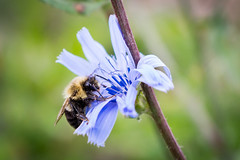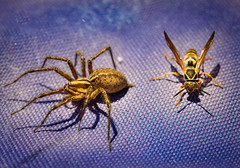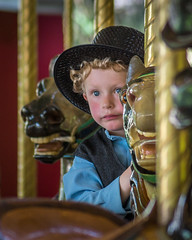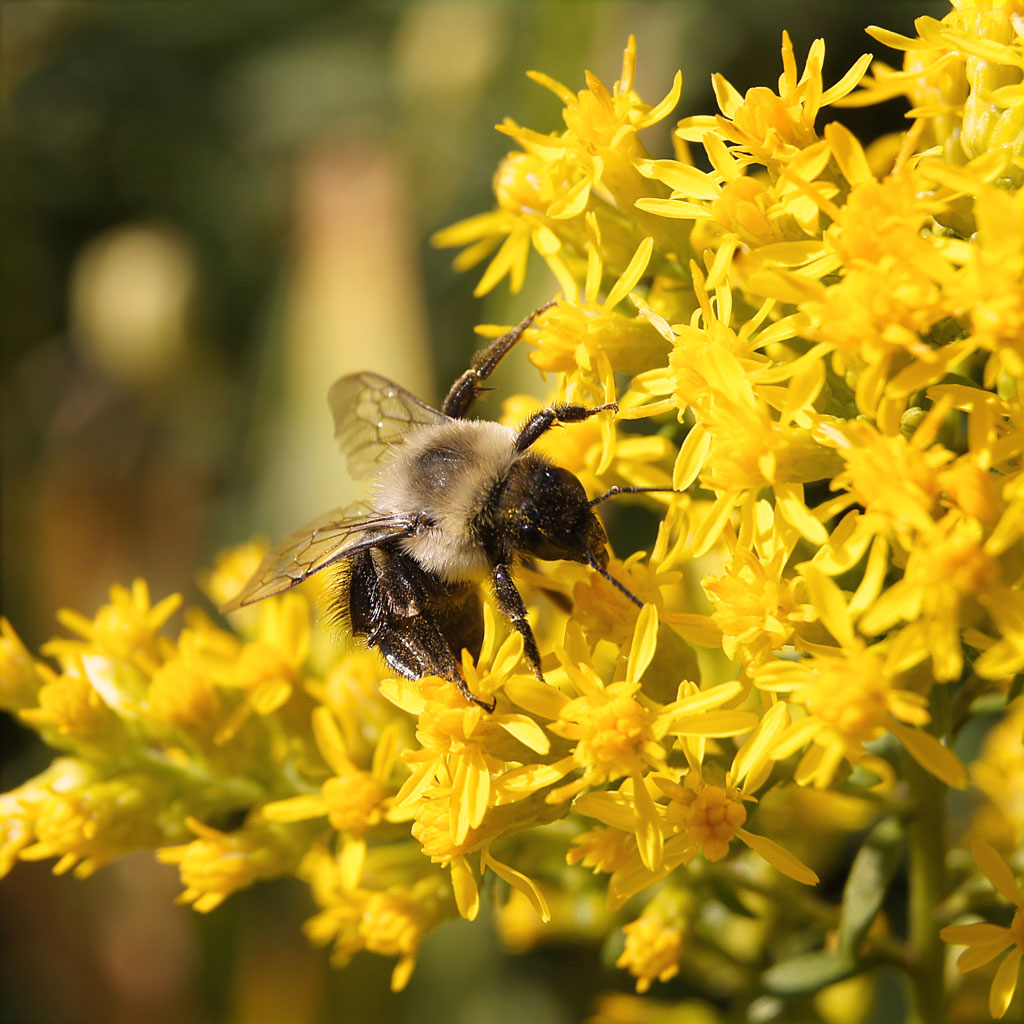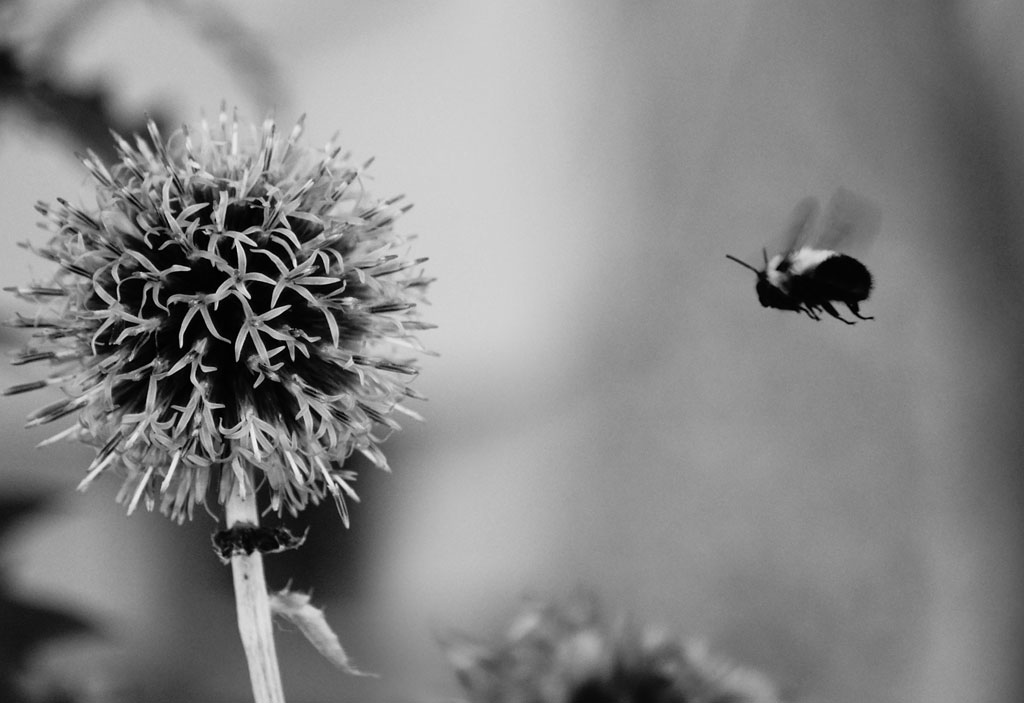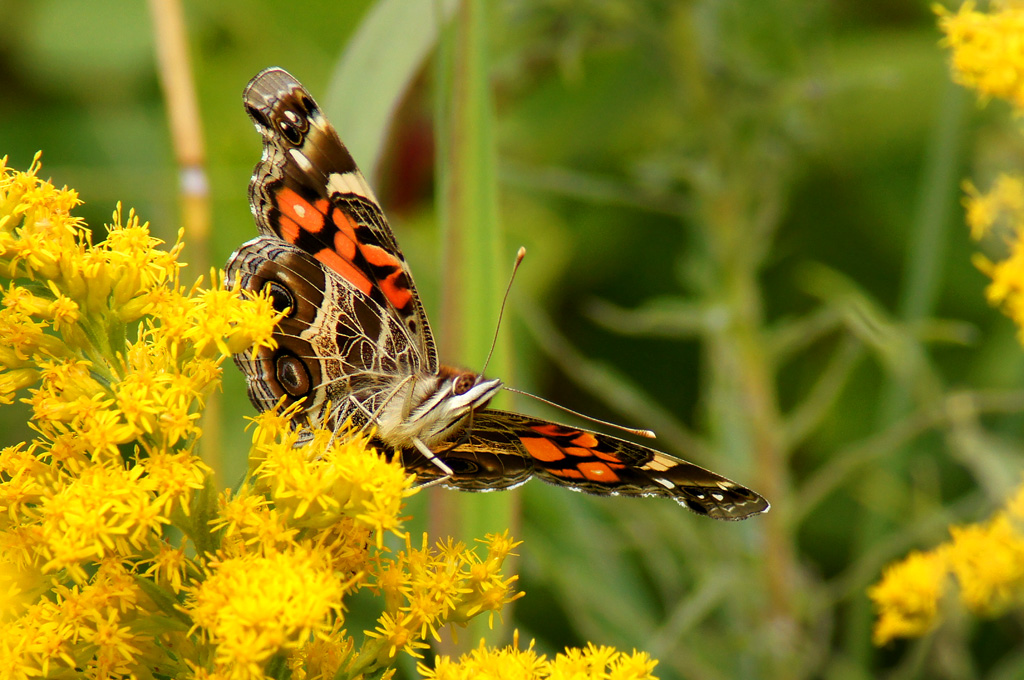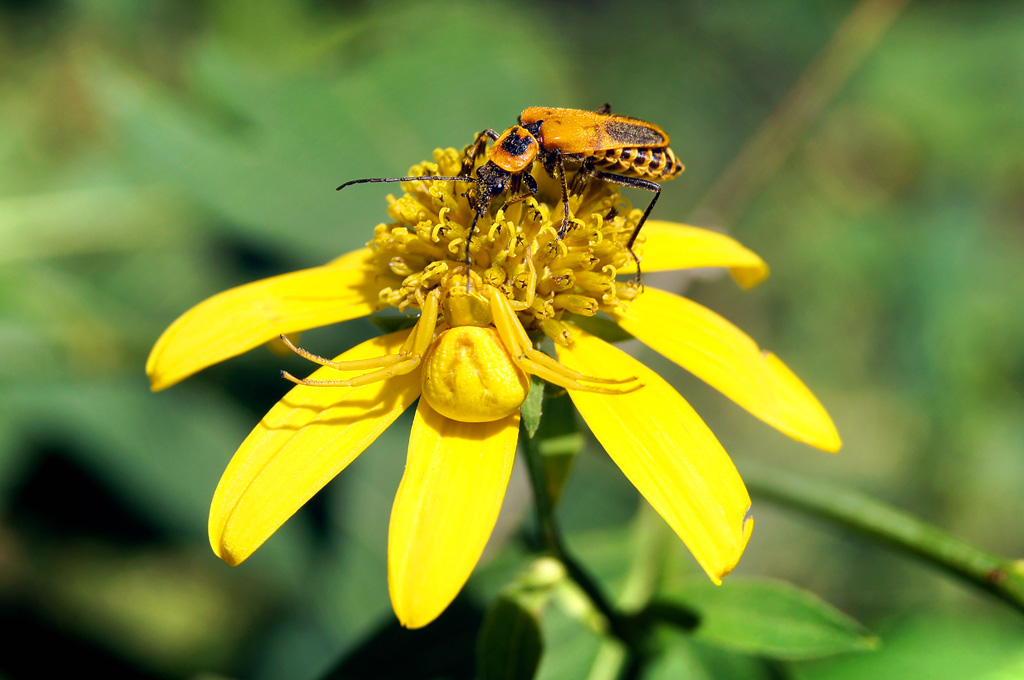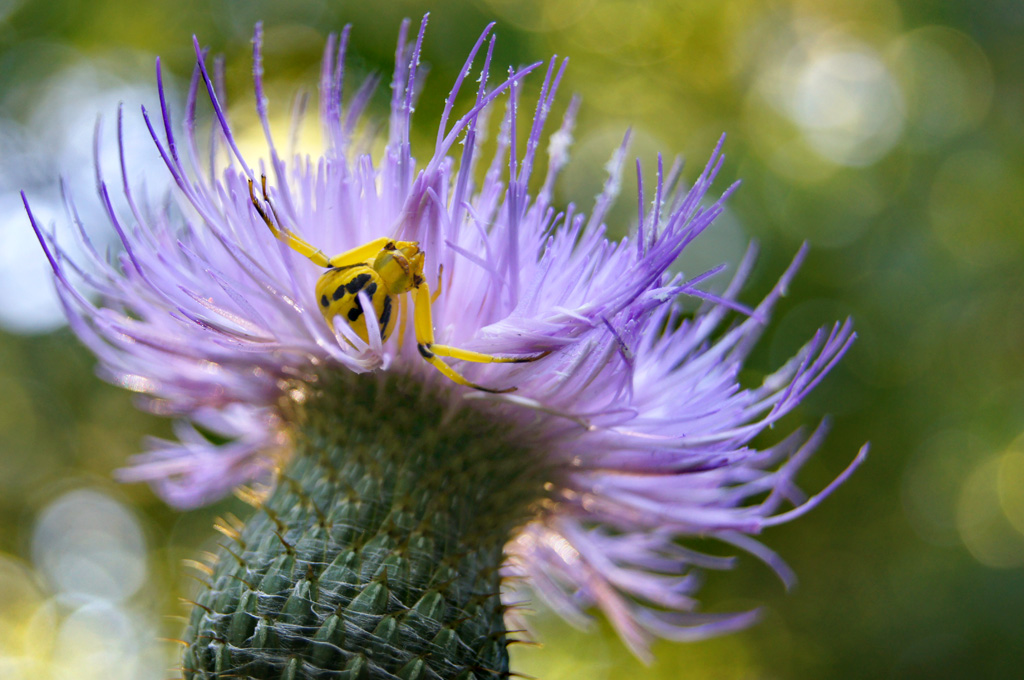Bugs
On Golden Rod
Found on the Web
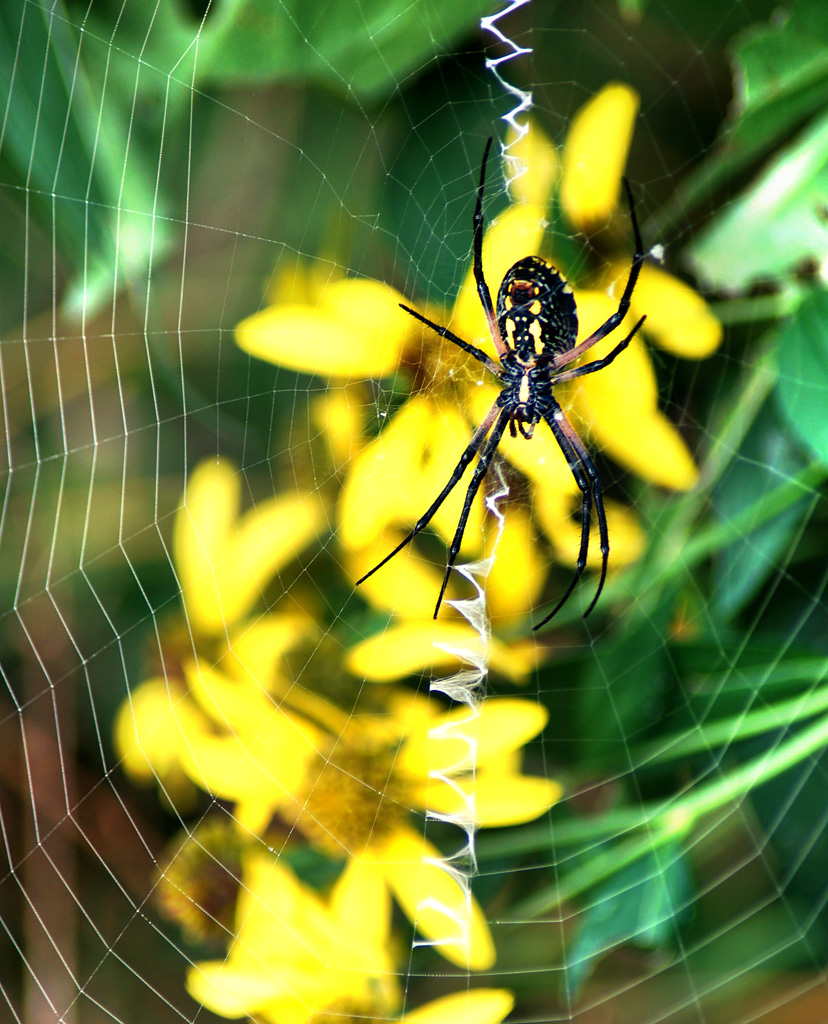 Let me introduce you to a web master. Spider web, that is. This beauty is commonly called a Yellow Garden Spider. The technical name is Argiope Aurantia. They are common in most of North America. We have them in our garden and flower beds each year. This one was photographed while on vacation last summer in Missouri. I saw the spider web and spider with a background of yellow wildflowers and thought it created an interesting visual.
Let me introduce you to a web master. Spider web, that is. This beauty is commonly called a Yellow Garden Spider. The technical name is Argiope Aurantia. They are common in most of North America. We have them in our garden and flower beds each year. This one was photographed while on vacation last summer in Missouri. I saw the spider web and spider with a background of yellow wildflowers and thought it created an interesting visual.
Here are some interesting facts about Argiope Aurantias from the University of Arkansas Anthropod Museum…
Females build large webs, up to two feet in diameter. The female usually eats her web each day and constructs a new one, often in the same place. The web consists of dry spokes supporting a spiral thread of adhesive silk. The hub is separated from the spirals by a free zone. The spiders rest head down day and night at the hub of the web over a conspicuous zigzag band of bright white noncapture silk known as a stabilimentum. The stabilimentum apparently affords protection, perhaps by camouflaging the spiders, startling predators, or acting as an aposematic warning of the presence of webs. It seems to be especially effective in preventing birds from flying through webs.
For another view of the same type of spider, see my earlier post : By A Thread.
If you have a large monitor, clicking on the photo may provide a larger version.
Waiting for a Bus
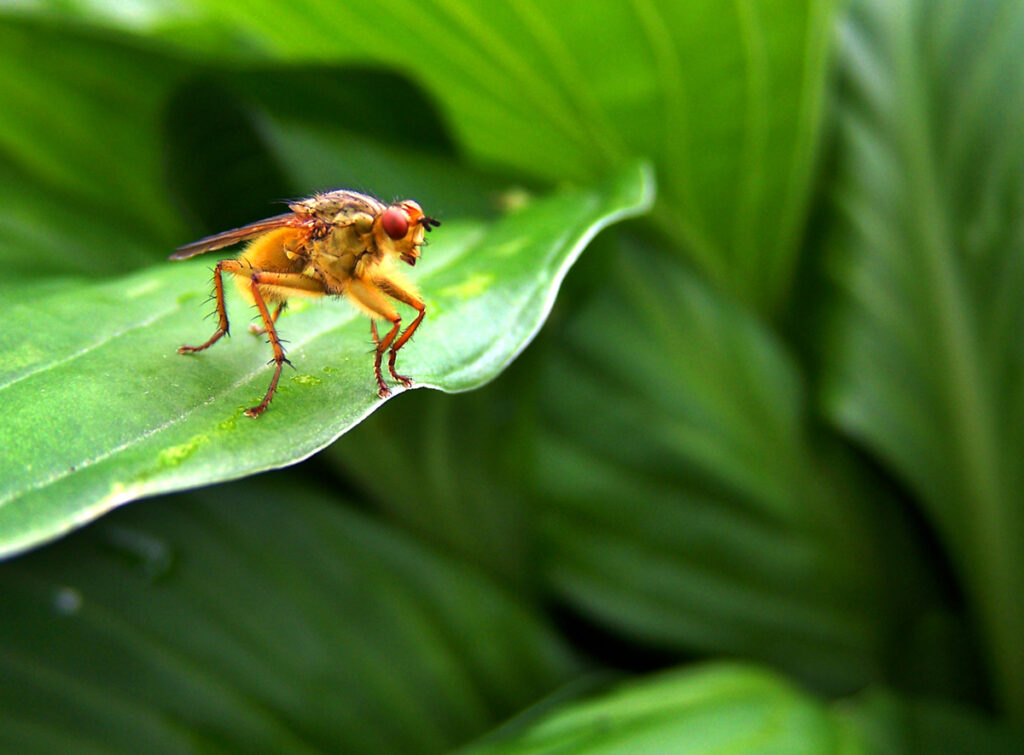 I found this odd looking bugger in one of my wife’s flower beds. Goofy looking and larger than a typical house fly, I worked on sneaking up on it to, hopefully, get a decent picture of it. To my delight and surprise, this guy didn’t seem to mind me. It sat there – just as you see him – while I moved within inches and snapped several photos.
I found this odd looking bugger in one of my wife’s flower beds. Goofy looking and larger than a typical house fly, I worked on sneaking up on it to, hopefully, get a decent picture of it. To my delight and surprise, this guy didn’t seem to mind me. It sat there – just as you see him – while I moved within inches and snapped several photos.
This is an image I captured several years ago using my consumer grade Kodak Easyshare DX7590. That camera was pretty good at macro work.
On a side note: I posted this yesterday on my Google+ account. Someone commented, “That’s a dung fly.” I think I would have preferred not to know that. Especially when I consider how comfortable it was with my presence. (If you’d like to follow me on Google +: https://plus.google.com/u/0/113684854375405108383/posts)
To get a better view of the bug, click on the photo.
The Beeline
Beeline (noun) 1. direct, straight course. 2. To move swiftly in a direct, straight course.
One of my “quests” this summer was to capture a bee in flight. They’re small, quick and errattic. Hard to catch in focus. So far, none of my efforts have come close to what I would deem, “successful.”
The image above is the best I’ve managed…so far…and it was by accident. (That happens more than I might like to admit.)
I was taking photos around a flower bed beside our house. While I was changing camera settings, I accidentally pressed the shutter button. A that exact moment, a bee happened to be zipping into the frame…and voilá.
If I were trying for it, I wouldn’t try in black and white, but looking at this, I really like the intensity it creates. The bee – with his straight antennae, trailing legs and blurred wings – looks like he is on a do-or-die mission and will not be denied.
To see a larger version of this image, just click on it.
To see more bee photos, check out the Bugs & Spiders gallery.
Brown-eyed Beauty
quest, (noun) 1. The act or an instance of seeking or pursuing something; a search.
I have been on a quest this summer…to find and photograph a butterfly. Seems simple enough. (Yeah, right.)
Every now and then I get a photographic target in my head. One of my targets this summer has been a butterfly image worthy of posting on this blog. Judging by the number of butterflies I’ve seen, much less snapped, butterflies have to be top candidates for some endangered species list. Of the very few I have seen, I’ve not been able to get a good, in-focus, shot of one.
In the last few days, I’ve spotted a few in a vacant field next to my work place. I trudged through the waist high weeds, trying to sneak up on them. They are skittish, flighty little buggers. When I did get one in focus, I couldn’t seem to get a good angle on it…where you can see the wings spread and colors displayed.
This image, though short of my ideal, is the best I’ve been able to come up with and the only one I’ve felt worthy of sharing. And, since it’s not my ideal, the quest will continue.
To get a better view of that brown-eyed beauty, click the image.![]()
By a Thread
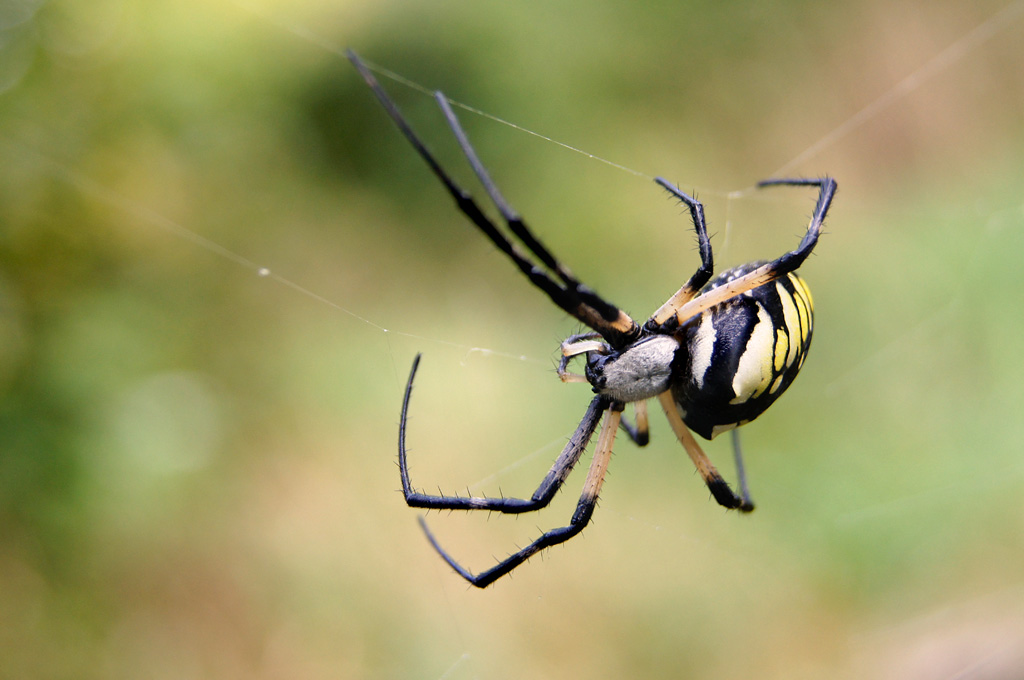 In the spider world, this is a common character. I’ve found and photographed this type in our gardens in Wisconsin. This one was photographed in the woods of Missouri.
In the spider world, this is a common character. I’ve found and photographed this type in our gardens in Wisconsin. This one was photographed in the woods of Missouri.
We typically refer to this as a Garden Spider. If you want to get technical, it’s a Black and Yellow Argiope (argiope aurantia).
If it won’t creep you out, you can view a larger version of this image by simply clicking on the photo.
The Stand Off
While photographing wildflowers I noticed yellow spiders hiding among the foliage. I believe they are in the crab spider family. They seemed to be waiting for prey to come by. That was, in fact, the case. (See some of my previous posts.)
I’d been photographing these yellow spiders on purple thistles. Then I noticed a similar spider on a yellow flower. While I was taking his picture, a soldier beetle landed on the flower. I wondered what would happen.
After taking a few photos, I decided to switch to taking video. I remembered nature films I’d seen where an alligator snatches an unsuspecting antelope that stopped for a drink. I thought this, on a decidedly smaller scale, might provide the same kind of drama.
I only got a short, six seconds of video. It looked like the solider beetle bumped into the spider and then flew off. Not too dramatic. However, when I slowed the video down, it turns out it was a much closer call than I originally thought.
Watch the video below and pay particular attention to the slow motion footage. When slowed down, you can see the spider actually grabs the leg of the soldier beetle in its jaws. The beetle is able to pull away before the spider can get a better hold. The best way to view it is to click the full-screen icon in the lower right corner of the video box.
Click on the photo at the top to see a lager version.
Fatal Attraction
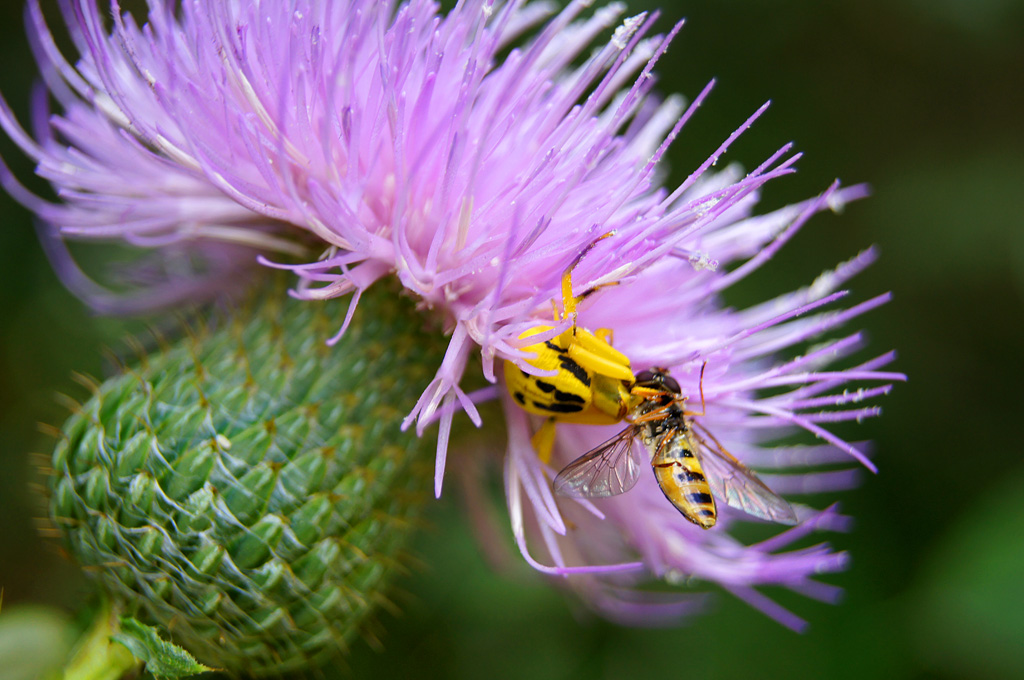
I discovered yellow spiders hiding among the the thistles. I assumed they were waiting for unsuspecting prey. I took some photos, downloaded them to my computer and posted them to this blog under the title Dangerously Alluring Beauty.
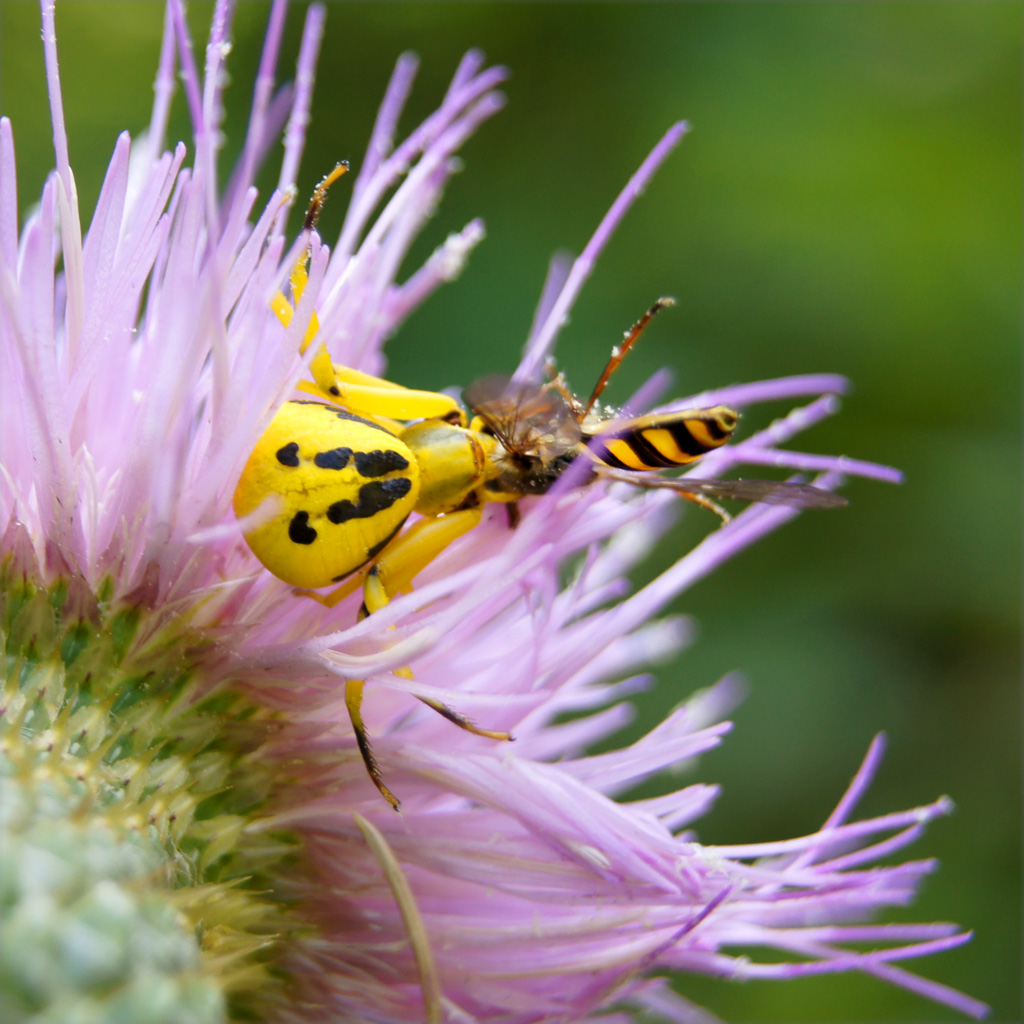 Several hours later, I went back to check on them. I was right! This is the same thistle and spider from the previous post.
Several hours later, I went back to check on them. I was right! This is the same thistle and spider from the previous post.
As you can see, a small bee, buzzing from flower to flower, attracted by the thistle, received an instant invitation to lunch.
The image on the right is the same scene from a different angle.
I wish I had hung around long enough to catch the action live. However, it just so happens, when I finished photographing this carnage, I noticed a similar yellow spider, poised with arms open wide, waiting for a its meal on a yellow flower. Then a bug came along. I started snapping pictures. The bug walked around the flower until it finally came face to face with the spider…and then…
You’ll have to watch for those images in a future post to see how it turned out.
To view larger versions of either of these photos, just click on them.
Dangerously Alluring Beauty
I went for another walk in the Missouri woods with my camera and noticed something new among the thistles.
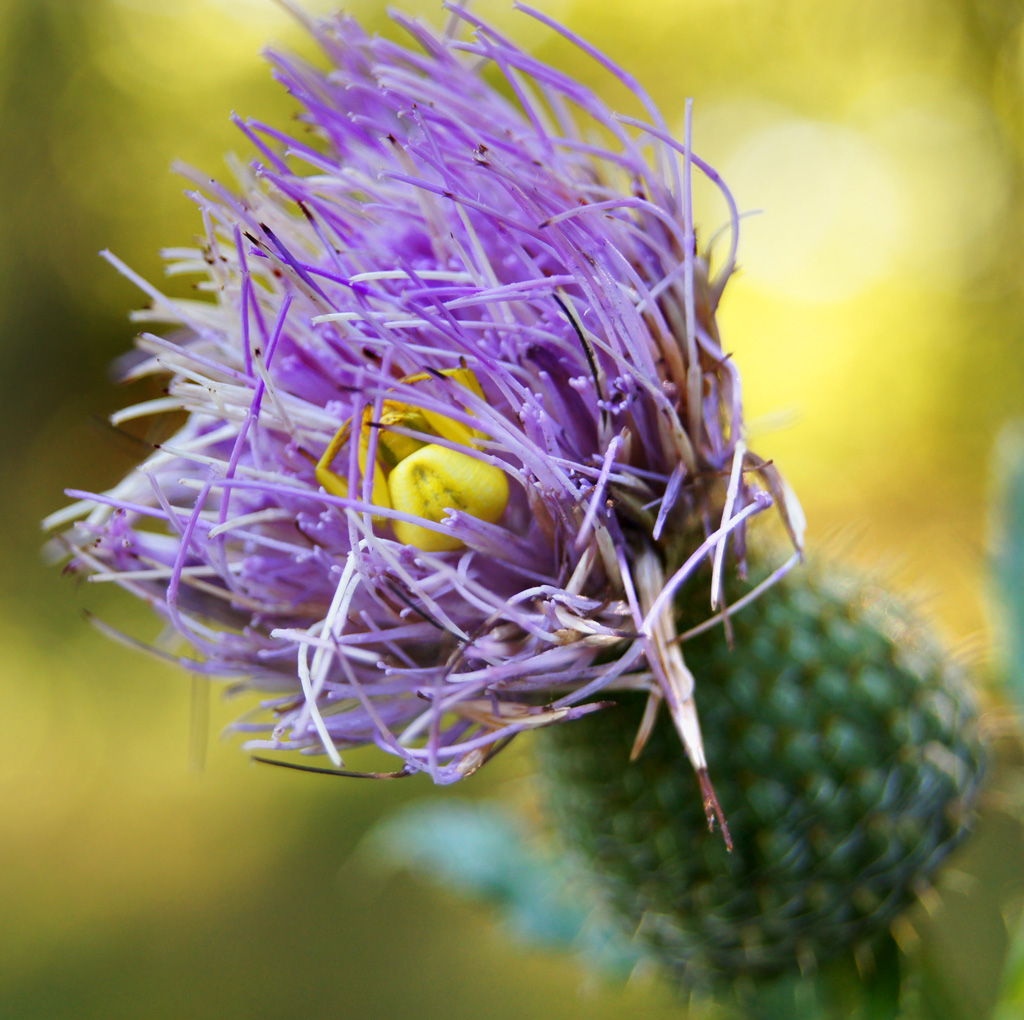 This yellow and black spider was strategically positioned and patiently waiting to strike insects who may be attracted to the colorful thistle.
This yellow and black spider was strategically positioned and patiently waiting to strike insects who may be attracted to the colorful thistle.
If you look closely at the image above, it looks like some of the thistle is twisted in strands to the side – giving the spider easier access to any prey that might land on the top of the flower. Is the spider smart enough to make an easier path to the kill or is it just a naturally occurring coincidence? I wonder.
The photo to the right show another spider snugly tucked deep in the strands of the thistle. Waiting…waiting…waiting…
Now that I look at them, maybe I should have waited to see and document what happens. It might have taken a long time with me just a few inches from the blossoms. The spiders are more patient than I am.
You can get a closer look at either photo by simply clicking on them.
Messy Hands
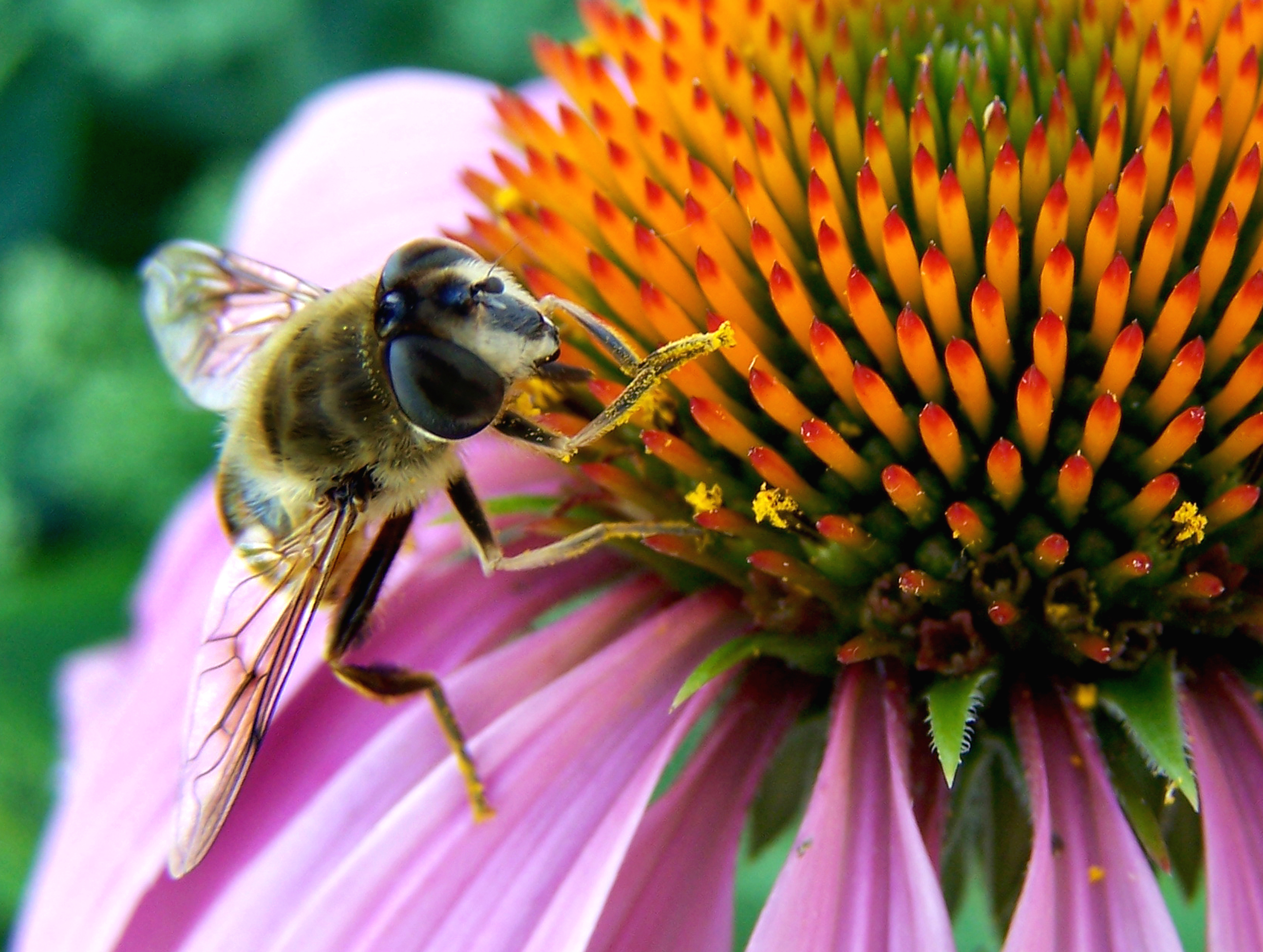
This is an image that dates back to 2006. This photo was the initial inspiration for my experimentation and reasonable success with macro photography.
My old camera, a Kodak Easyshare DX7590, did an exceptional job with macro shots. When I saw what was possible – after taking this image – I started to major on the minors. I can spend hours crouched down by a flower bed, moving slowly, trying to be unnoticed while I position my camera as close as possible to any tiny creatures I can find. I was just a few inches from this bee when I snapped this photo.
I love seeing the normally, unseen details of God’s creation. For instance, in this image, I am fascinated by the bee’s wings, the pollen on the flower and bee’s legs, that little dongle thing protruding from the bee’s head, it’s eyes and the orange tipped spears of the cone flower.
If you find this image appealing, please feel free to share it with friends. (If you’re on Facebook, simply click one of the Facebook links below this story.)
To see a larger version and even more detail, click the photo.
All of the photos I post are available for purchase. If you’d like to buy one, click on the blue “Buy this Online” bar below for a variety of print and frame options or contact me for digital purchase and licensing options.






